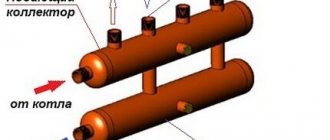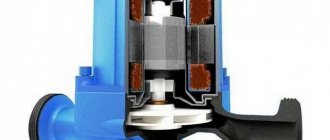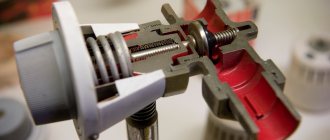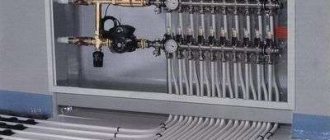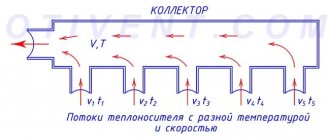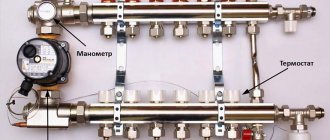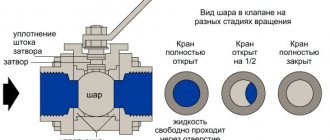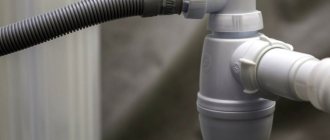Thermostatic head operating principle
- The main sensor is a bellows, in which the liquid or gas is under a certain pressure. The adjustment spring is responsible for balancing the device, which compresses the bellows when we set the temperature we need by rotating the rotary handle.
Thermostatic head operating principle
Note! The better the calibration of the device, the more accurately it will respond to temperature changes. At the same time, the price of such high-precision thermal heads will be appropriate.
- As the temperature rises, the volume of the bellows increases (mainly due to gas expansion or partial evaporation of the working fluid).
- An increase in the volume of the bellows leads to the fact that the spring fixing the rod is released, and the valve gradually closes the gap in the pipe.
- This continues until equilibrium is established inside the device, or until the radiator valve under the thermal head is completely closed, i.e. the rod will not go to its lowest position.
Models with remote elements work according to a similar scheme. The only difference is that either special programmable devices (climate control systems) or remote sensors (liquid, gas or electronic) react to temperature changes. Only after this the information reaches the thermal valve mechanism and activates the rod.
Device and principle of operation
The devices offered on the market have the same design. They also function according to the same principle. Main nodes:
- valve;
- thermal head with rod and bellows.
The last of the elements is removable. You can connect different thermal heads to one valve. The device of the electronic analogue is somewhat more complicated: the design includes a microprocessor responsible for regulating the temperature in the room. The operating principle of the thermostat is based on changing the cross-section of the valve lumen. To normalize the indoor microclimate, you need to reduce the volume of coolant that enters the radiator from the pipe.
The thermal valve is connected to the head via a union nut and a rod. The last of the elements moves inside the structure under the influence of the load exerted by the medium in the bellows (gas, liquid). When heated, the substance expands. The pressure inside the head increases. As a result, the rod lowers, partially or completely blocking the gap in the valve.
When the air in the room cools, the thermostat settings are changed manually or automatically. If a device equipped with a bellows is installed, the stem returns to its original position after the characteristics of the working environment change. Electronic devices interact with the thermostat. This element is often built into the design of the thermostat. There is another option: install a thermostat on the radiator.
The market also offers simpler thermostats - mechanical ones. They are equipped with valves and taps. Such devices are distinguished by their primitive design. They contain a valve, valve. There is no bellows inside the structure. All actions to adjust the parameters of the coolant and the environment are performed by a person: if necessary, the valve partially blocks the gap inside the valve, which leads to a decrease in the volume of the coolant. When the air in the room cools down, it is necessary to return the device to its original position.
Installing a thermal head on a heating radiator
Before starting work, it is important to know how to correctly install the thermal head on the radiator; the further functionality of the device will depend on this.
What you need:
- Thermal head
- Thread cutting die
- Fumlenta
- Two adjustable wrenches
- Locknuts
Preparatory work
Typically, the installation of a thermal head on a battery is carried out together with the installation of new radiators. To do this, you need to shut off the riser and drain the remaining coolant in the pipes into a bucket. It is best to carry out work outside of the heating season.
Choosing a location for installing the thermal head
Taking into account the errors in installing the thermostatic head, which we discussed above, we can draw conclusions about where exactly the thermostatic head should not be installed. What will be the best options? It is important that it is not exposed to heat flows from the radiator and is not affected by factors that can cause a false perception of temperature.
The photographs below show common options for correctly installing the thermostatic head on batteries. If it is mounted at the top of the radiator, it should only be positioned horizontally. In the lower part it can be mounted horizontally and vertically, since there are no strong thermal flows of heated air - it rises to the top.
Carving pipes
To secure the head to the radiator, it is necessary to cut threads at the attachment points. To do this, threads are cut using a die on the pipes coming from the riser and radiator.
Head mounting
A lock nut is screwed to the outlet coming from the riser. It is wrapped with fumlenta, and the thermostat is screwed onto it, but the fasteners are not tightened. Next, do the same with the flow coming from the radiator. The installed thermal head must be secured - simultaneously tighten both nuts with two adjustable wrenches.
Types of heads by design
Thermostatic devices are distinguished by type of design. They are selected depending on the characteristics of the pipeline of a particular heating system and the method of installation to the radiator.
It is also necessary to take into account the peculiarities of the head installation. This node was always located horizontally. In this position the device will be more effective. The head will be better washed by air currents.
There are devices on sale that stand alone without radiator valves or together with them. The Danfoss thermostatic valve, for example, has exactly this arrangement. But the company produces completely different systems. Instead of a scale, this product has a special diagram on it, according to which you can make precise adjustments.
But the use of such equipment is not always advisable. In this case, instead of automatic solutions, you can use other types of valves. The difference here is that the adjustment is carried out not automatically, but in manual mode. Adjustable valves and thermal heads are installed on the supply line. It is recommended to install simpler fittings at the return outlet from the battery.
Types of radiator thermal heads
Battery thermostats are classified according to two factors. The first is a heat-sensitive compound in the bellows. Filling can be liquid or gas-filled. The latter, due to their lower inertia, are faster in operation. The second principle of separation is based on setting and control - manual, mechanical or electronic.
Manual thermal heads
They are characterized by a simple design and accessibility. They are a modification of a conventional tap. The regulator shows a scale with divisions corresponding to temperature. Allows you to change the temperature of the heating radiator to an exact value instead of an abstract value, as happens with a standard tap.
Devices of this type have several disadvantages. You have to adjust the heating manually, based on your own feelings. It is impossible to change the temperature during sleep and outdoors. Also, during active use, the moving parts of the valve quickly fail and may require replacement of the entire structure.
Advice! After the end of the heating season, the device is removed to avoid sticking of the moving elements.
Mechanical
Provide control of room temperature in autonomous mode. The moment the thermal head starts operating is determined by selecting degrees on the scale. Each division allows the rod to close the coolant valve only to a certain level.
Compared to manual thermal heads, mechanical ones provide the opportunity to save heat energy around the clock. The difference in cost quickly pays for itself, compatibility with different types of heating radiators is high.
Electronic
They have an expanded range of functions. The principle remains the same, but the valve closing process is controlled by a microprocessor. It is possible to fine-tune:
- programming by days of the week;
- Adjustable by the clock - cooler during the working day, warming up before returning;
- clear indication of device operation.
The disadvantage is the high cost compared to mechanical analogues. Also, many models are larger in size than other types - this can be a problem when installed in limited space.
The disadvantage of electronic models is limited access to the control unit, convenient placement is not always possible
Types of thermal heads and their operating principles
Thermal heads are classified as shut-off and control valves.
There are three types of thermostatic heads:
- manual;
- mechanical;
- electronic.
The functions are the same in all, but the implementation methods are different. Depending on the last parameter, they have different capabilities.
What are manual thermal heads?
In terms of design, thermostatic heads duplicate a standard faucet. By turning the regulator, you can regulate the volume of coolant transported through the pipeline.
By setting your thermostat just 1° lower, you can save 6% on your annual energy bill in one year.
They are mounted instead of ball valves on opposite sides of the radiator. They are reliable and inexpensive, but they will have to be controlled manually, and turning the valve every time, relying solely on your feelings, is not very comfortable. Basically, such thermal heads are installed on cast iron batteries.
If you move the valve stem several times a day, the valve handwheel will become loose. As a result, the thermal head will quickly fail.
Features of mechanical thermal heads
Mechanical type thermal heads have a more complex design and they maintain the set temperature automatically.
The device is based on a bellows in the form of a small flexible cylinder. Inside it is a temperature agent in liquid or gaseous form. As a rule, it has a high coefficient of thermal expansion.
As soon as the set temperature exceeds the norm, under the influence of the internal environment, which has greatly increased in volume, the rod begins to move.
As a result, the cross-section of the thermal head passage channel narrows. In this case, the battery capacity decreases, and, consequently, the coolant temperature decreases to the set parameters.
As the liquid or gas cools in the bellows, the cylinder loses its volume. The rod rises, increasing the dose of coolant passing through the radiator. The latter gradually warms up, the balance of the system is restored and everything starts all over again.
A positive result will only be if there are thermostats in all rooms and on each radiator.
Devices with bellows filled with liquid are more popular. Although gases have a faster reaction, their production technology is quite complex, and the difference in measurement accuracy is only 0.5%.
A mechanical regulator is more convenient to use than a manual one. He is fully responsible for the microclimate in the room. There are many models of such a thermal valve, differing from each other in the way the signal is sent
The thermostatic head is mounted so that it is oriented towards the room. This will improve the accuracy of temperature measurement.
If there are no conditions for such an installation, install a thermostat with a remote sensor. It is connected to the thermal head by a capillary tube 2 to 3 m long.
The feasibility of using a remote sensor is due to the following circumstances:
- The heating device is placed in a niche.
- The radiator has a depth of 160 mm.
- The thermal head is hidden behind the blinds.
- The window sill above the radiator is wide, despite the fact that the distance between it and the top of the battery is less than 100 mm.
- The balancing device is located vertically.
All manipulations with the radiator will be performed based on the temperature in the room.
How are electronic thermal heads different?
Since, in addition to electronics, this thermostat contains batteries (2 pcs.), it is larger in size than the previous ones. The rod here moves under the influence of the microprocessor.
These devices have a large set of additional functions. So, they can set the temperature by the clock - at night the room will be cooler, and by the morning the temperature will rise.
It is possible to program temperature readings for individual days of the week. Without reducing the level of comfort, you can significantly save on heating your home.
Although the batteries have enough charge to last for several years, they still need to be maintained. But the main disadvantage is not this, but the high price of electronic thermal heads.
The photo shows a thermal head with a remote sensor option. It limits the temperature to a set value. Adjustment possible from 60 to 90°
If a decorative screen is installed on the radiator, the thermal head will be useless. In this case, you will need a regulator with a sensor that records the external temperature.
Rules for installing a thermal head
The connection location when installing a thermal head on a radiator does not depend on its type. In any case, this is a pipe that directly supplies coolant to the battery.
For the device to work correctly, air must continuously circulate around it.
Connection recommendations
Each manufacturer gives recommendations regarding connecting the thermal head.
Despite this, there are general installation conditions:
- The housing must be protected from direct ultraviolet rays. Otherwise, the device will not work accurately.
- The thermal head must be open. It should not be hidden by any protective boxes or furniture.
- The device must not be located above heating pipes. In this case, there will be a discrepancy between the room temperature and the area around the head.
- If the device is practically isolated, you need to install a bypass line or install a bypass valve in the area of the supply pipe and return pipe.
- The connected piping must not exert pressure on the valve body.
Settings Features
In order for the thermal radiator valve to function correctly, preliminary settings must be performed. You need to turn on the heating in the room and close the doors and windows. A thermometer is placed at a certain point, after which the settings are made. The device setup diagram is as follows:
- Turn the thermal head to the left until it stops. This will open the coolant flow.
- Expecting a temperature increase of 5-6°C compared to the one in the room.
- Turn all the way to the right.
- Waiting for the temperature to drop to the original temperature. Gradually unscrew the valve. Stops rotation in case of positive noise or heating of the radiator.
The last position set is optimal and corresponds to a comfortable temperature.
Rating of thermal heads for heating radiators
When purchasing, it is better to focus on manufacturers that have proven themselves for a long time. In each category there are leading positions that have collected the best reviews about work and quality of execution.
Danfoss
Danish company using advanced developments. New models allow operation to be controlled by an application on a smartphone. The budget model RTS Everis is a thermocouple with adjustment from 8 to 28 degrees. For stability and maximum service life, it is installed on a valve from the same company.
Ergonomics, clarity, laconic design - 60 years of experience in the thermostat market
Thermo
Swiss brand, leader in reliability and durability of devices. Features include a wide temperature range. They are demanding on the temperature of the coolant - exceeding the level of 100 degrees has a negative effect. The most commonly chosen models are the Royal Thermo line.
Many Royal Thermo models are equipped with a remote sensor
Caleffi
They specialize in electronic thermal heads. They are distinguished by clear indication on the display and programmable operating modes. There are mechanical and manual representatives - like Caleffi 210000.
All Caleffi heads are supplied with mounting hardware
Oventrop
German manufacturer of devices and systems for residential premises. Despite the lack of specialization in the production of thermostats, they produce high-quality devices. They are characterized by high maximum loads and installation versatility. The best model is Uni LH, with a built-in or remote temperature sensor.
Oventrop thermal heads have an ergonomic design and high quality
Honeywell
Budget German devices. They are distinguished by a pleasant design, compatibility with most valves, protection against freezing and mechanical damage. The Thera-100 and Thera-4 Classic models are in high demand.
There are also expensive electronic HONEYWELL models, but there are not many of them on the market yet! Before purchasing imported devices, it is better to once again check the possibility of installing the valve on old-style radiators.
Danfoss thermostat - operating instructions
Installing a thermostat on a radiator is an opportunity to reduce heating costs, improve the microclimate in the house, and also carefully use the earth's energy resources.
The motives may be different, but the decision is being implemented more and more often.
Many people, when choosing an equipment manufacturer, choose Danfoss.
And not surprisingly, products from a well-known brand can easily be found on the shelves of many stores.
The production technology of their thermostats based on a gas-filled bellows is patented and used in the company’s own factories. If you also decide to purchase a Danfoss thermostat, the installation and operating instructions will come in handy.
The purpose of installing a thermostat is to maintain the air temperature in the house chosen by the consumer.
The design of a thermostat for radiators includes two elements that complement each other:
- Thermostat (or thermostatic element).
- Danfoss thermostat valve.
The valve is connected directly to the battery, and a thermostatic element is installed on it.
The heart of the matter is the thermostat. It is he who reacts to changes in ambient temperature and affects the valve that blocks the flow of coolant.
Danfoss thermostat
Inside the thermostat head is a bellows (a corrugated chamber capable of changing dimensions) filled with gas. The gas, depending on the temperature, changes its state of aggregation (when cooled, it condenses). This leads to a change in volume and pressure in the chamber. The chamber decreases in size and pulls the spool rod with it, which opens a larger gap in the valve for the flow of coolant.
When heated, a reverse process of expansion and closure of the lumen occurs (the accepted standard is 2 V ° C in excess of the air temperature above the set one).
Attention when purchasing
Radiator handle and thermostatic head have different efficiencies. Therefore, before purchasing, you need to find out the opinion of experts. This will avoid mistakes.
When choosing, you should also pay attention to the energy efficiency class. The radiator handle has the symbol DELL followed by a letter symbol from A to F. The operating principle and adjustment of these valves are the same, but the products differ in efficiency. The thermal head of the radiator, signed with the DELL A mark, meets the requirements of the highest efficiency class. Heads marked DELL F indicate the lowest efficiency.
Higher efficiency often means slightly higher purchase prices. However, it should be remembered that a more efficient thermal head will lead to a more noticeable reduction in heating costs for the building. The valve has a protruding rod, which, when interacting with the head, closes or opens, reducing or increasing the flow of coolant through the radiator. Incorrectly selected elements can cause the device to malfunction, which will lead to significant discomfort during use. One of the most important selection parameters is the stem length, or the distance from the valve to the head. It is also necessary to pay attention to the possible type of connection - the liner or valve can be adapted to accept a screw-on threaded head or to accept a snap-on installation device.
Regulator design
The design of the heating regulator for the battery includes the following elements:
- valve or valve;
- thermostatic mechanism.
Control device design
A thermostat or thermal valve is a standard valve in a housing with a control mechanism.
The cone is considered a locking element, which, when moving, changes the amount of coolant.
The movement of the cone is facilitated by a thermal head, consisting of a cylinder with a thermal component.
The cylinder is called a bellows, and a special liquid or gas is used as thermal components.
When heated, this component expands in volume and tightens the cylinder, which moves the conical part.
The cone blocks the flow of coolant and the composition cools down.
At the same time, the bellows becomes smaller.
Then the cone rises, and the liquid moves into the battery and helps heat the thermal head of the equipment.
This technique allows you to maintain the desired temperature.
The structure of a thermostatic head for radiators. Arrows indicate the components of the device.
When the temperature drops below the set value, the bellows filler decreases in volume and the opposite process to that described above occurs. The coolant circulation increases and the room temperature rises to the desired value.
Thermal valve for heating system
The thermal head is installed strictly horizontally and contains a specific meter that transmits signals to the electric drive about the closing or opening of the valve. The hydraulic valve has three coolant passages, two of which are used to supply water to the mixer, and the third is responsible for supplying the total flow to the pipeline.
The block is made of stainless steel, since the device has to work in a constantly humid environment and there is a risk of corrosion. In operating mode, the floors sensitively respond to changes in heat in the room, automatically adjusting the heating of the circulating fluid inside.
Benefits of using a thermostat
Modern thermostats have many advantages. One of them is extreme ease of use. Such devices are easy to install and further use, and it’s not difficult to understand. Modern devices help create the most favorable and comfortable indoor environment. They allow you to significantly save on heating and use resources as rationally as possible.
The operating principle of the device is based on changing the valve cross-section.
The thermal valve is connected to the head by a rod and a union nut. The rod moves under the influence of the load from gas or water, which expands during the heating process. The pressure increases inside the head, the rod gradually moves down, completely or partially closing the valve lumen.
Features of setting the thermostat for heating pipes depend on the control system:
- an automatic device with a bellows is distinguished by the ability of the rod to return to its original state when the characteristics of the medium change;
- The electronic type of regulator is equipped with a thermostat. The temperature level sensor is built into it or mounted on the radiator;
- mechanical devices, the design of which includes a valve and tap, are produced without a bellows, and have a manual operating mode - the user must turn the valve handle.
In order to save money, thermostats are installed on batteries; with their help, the cost of maintaining heat in the room is reduced by 25%. However, for greater efficiency, it is necessary to choose the right device for a specific heating system and install it. In addition, it is worth studying in detail the instructions on how to properly install the thermal head on the radiator.
Kinds
According to the method of transmitting the signal to the thermal element, it can come from the coolant, indoor air. The valve of different types can be almost identical. They will differ in the thermal head. Today, all existing varieties can be divided into 2 types: mechanical and electronic. Devices have their own characteristics, which affect their performance characteristics.
The devices differ not only in the type of material, but also in the installation method. They can be of angular or straight (pass-through) type, depending on the type of connection. For example, if the main is connected to the side, a direct type valve is installed. The corner method is used when connecting from below. The valve option is chosen to be the one that fits best into the system.
The choice between them depends on the preferences of the buyer and his financial capabilities. Products can be designed for a specific type of thermoelement. To understand the differences between thermostats, you need to briefly note their main nuances.
Mechanical
Mechanical thermostats are easy to use, precise and consistent in use. They do not need a network connection. Manual products are different from their electronic counterparts. They work on the principle of a regular faucet: the regulator is turned in the desired direction, allowing the required amount of coolant to flow through. The devices are cheap, but not the most convenient, since to change the heat transfer you need to manually turn the valve each time.
If you install them instead of ball valves, you can use any of them to adjust. The devices are technologically advanced and do not require preventive maintenance. However, often there are no markings at the inlet and outlet of radiators of this design to adjust the heating temperature. Almost always you have to set it experimentally.
Before installing such structures, it is necessary to adjust them, as well as install hydraulic resistance. Smooth adjustment is carried out due to the throttle mechanism, which is located inside the device. This can be done on one of the valves (inlet or return). The operation of a mechanical thermostat depends on the hot and cold points inside the room, as well as the direction of air movement in the room. Another disadvantage is the fact that they react to the operation of household appliances with their own thermal circuits (for example, refrigerators, electric heaters, and hot water pipes).
Electronic
Such modifications are more complex in design compared to manual analogues. With their help you can make your heating system flexible. They not only allow for temperature control of an individual radiator, but also provide control of the main components of the system, including the pump and mixers. Depending on the model, programmable devices are equipped with different types of sensors.
The electronic mechanism can measure the ambient temperature of a specific space (the place where it is installed). Using the software, the received data is analyzed and a decision is made to reduce or increase the temperature. Such a mechanism can be analog or digital. The digital version has 2 modifications: its logic can be open or closed.
The difference between the categories is that products with closed logic are not able to change the functioning algorithm. They remember the level of the initially set temperature and maintain it. Analogs of open logic are able to independently select the desired control program. However, they are rarely used in domestic conditions, since it will be difficult for the average buyer to initially program them, selecting the desired options from the many built-in functions.
Remote sensor
Most thermal heads are equipped with built-in temperature sensors , but in some cases the operation of such models is ineffective.
The use of a remote sensor, mounted at a distance from batteries, window openings and other sources of temperature changes, is required if:
- there is no possibility of ensuring a constant flow of air to the device body: the radiator is installed in a wall niche, covered with a curtain or false wall, the distance from the top edge of the radiator to the window sill is less than 100 mm;
- convection currents affect the accuracy of the built-in sensor readings;
- the device body is exposed to direct sunlight;
- there is no way to eliminate drafts, which also have a detrimental effect on the accuracy of the readings of the built-in sensor;
- Horizontal installation of the thermal head is not possible.
In most cases, the use of remote sensors is not necessary; experts agree that optimal performance of thermostatic heads is achieved only by using such peripheral devices.
Advantages of modern thermostats
The models of thermostats that are currently produced are not only easy to use, but also have an aesthetic appearance suitable for the interior of almost any room.
It is worth noting that the installation of these devices is simple not only in new heating systems, but also in existing ones. In addition, according to experts, they have a fairly long service life, during which virtually no preventative or maintenance is required. After installing thermostats, there is no need to regulate the temperature by opening windows or doors.
Thermostat for radiator
The temperature range for normal operation of this device is 5–27 °C, you can choose the required temperature yourself and it will be maintained in the room with an accuracy of 1 °C. In addition, a thermostat installed on the radiator allows you to prevent excessive heating of the air in the room due to direct sunlight, electrical appliances or the accumulation of a large number of people.
Thermostats can not only create thermal comfort in the room, but also ensure uniform distribution of coolant throughout the entire heating system. If the device is installed on the boiler, absolutely all radiators will have the same temperature, even those that are located at the maximum distance from it.
It is worth noting that when installing a thermostat, it is best to start with those rooms in which sharp temperature fluctuations are observed, for example, a kitchen, rooms located on the sunny side, or a living room in which a large number of people can gather at the same time.
Quite often, thermostats are used in autonomous heating systems, since their installation reduces fuel costs by 25%. This, in turn, reduces the amount of harmful waste resulting from its combustion and reduces the cost of heating.
The advantages of using thermostats in a heating system are quite significant; their use can be particularly effective in private homes and cottages, because in this case, the installation of these devices pays off due to fuel savings literally in a year.
The installation of thermostats in private homes should begin with the upper floors, since there is usually a significant difference between the temperature on the lower floors and the temperature in the upper rooms.
High economic efficiency can be ensured by panel radiators that have a significant response rate to the opening and closing of the thermostat valves.
When choosing a thermostat, you should pay attention to the presence of a certificate of quality and compliance; high-quality devices always have such documents. The service life of such products reaches 20 years
Common Mistakes
Correct installation requires attentiveness from the master at every stage of work in order to avoid mistakes. The most common problem is the vertical position of the head. This leads to the fact that the room stops heating, since the thermostat itself heats up from the incoming air.
Often the wrong installation location is chosen. You cannot install the regulator at a point where the air temperature is very different from the average in the room. Due to the wrong choice of installation location, the use of a thermal head loses its meaning.
Criterias of choice
Electronic wireless thermal head with WiFi
Temperature control products are produced by many well-known companies. These include Buderus, Danfoss, Oventrop. They have their representative offices in all major cities.
To choose the best device, you should rely on the following criteria:
- Thermal valve on which the head is fixed. There are clip and threaded connections.
- Type of thread on the thermal head itself. It comes in the form of a nut with curtains or round.
- The presence of a skirt. It hides the working part and makes the appearance more attractive.
- Material. The cheapest devices are made of plastic, the most expensive ones are made of metal. The first ones are unreliable and short-lived.
- Quality of material. The use of cheap plastic reduces the cost of the design, but this affects strength and operating time.
- Work item type. There are liquid, gas, electronic, paraffin. Danfoss thermal head
- Smooth turning of the handle. Affects the accuracy of setting characteristics.
- Availability of additional characteristics. There are wireless models with WiFi, various sensors and other control and adjustment devices.
- Graduation, scale length.
- Is there anti-vandal protection?
- Appearance.
Stores offer ready-made kits consisting of a valve and a thermal head. If desired, these elements can be purchased separately. In particular, you have to purchase a thermostat separately for Rifar and Kermi radiators. Danfoss devices are very popular.
It is also worth choosing in advance which thermal head will be used according to the control method. A thermostatic head for a heating radiator with sensors and an automation system is more convenient, but is not suitable for all types of batteries.
For cast iron heaters, only models with manual adjustment are suitable. This is due to the heat capacity of the material and its high inertia.
How to choose
Based on the characteristics of the heating system, as well as the conditions of its installation, various combinations of valves and thermal heads can be used to control the temperature.
So, for example, for use in single-pipe systems it is worth using valves with a higher throughput.
The same applies to those two-pipe systems in which water circulation is carried out by gravity, that is, naturally, without forced mechanisms. In cases where a two-pipe system is used where there is a circulation pump, it is recommended to choose those types of valves where it is possible to adjust the throughput.
After selecting the valve, you need to select the thermal head.
The most common options that can be purchased today are:
- having an internal thermoelement;
- electronic (which can be programmed);
- having an external temperature sensor;
- anti-vandal;
- having an external regulator.
Most often, classic thermostats with an internal sensor version are installed in cases where their axis will be in a horizontal position.
Please note: the thermostat cannot be installed vertically, as the heat emanating from the housing piping will greatly affect the bellows, causing the entire device to function incorrectly.
In addition to vertical installation options, there are also other reasons to purchase a remote version of the sensor:
- if heating radiators with a temperature regulator located on them will be located behind the curtains;
- when there is any other heat source next to the installed thermal head;
- if the location of the battery is under a large window sill.
Very often, in rooms where interior requirements are increased, batteries are covered with decorative screens. Due to this, the internal thermostat will only register the temperature that is inside this casing. In this case, access to the thermal head adjustments will be blocked. Therefore, in such cases, it is recommended to opt for a remote controller with a temperature sensor.
It’s worth knowing: if you haven’t purchased heating radiators yet, you can buy Kermi models with built-in temperature sensors.
If we talk about electronic thermostats with a display, then they come in several types; the first have a built-in control unit, and the second have a removable control unit. The latter have the peculiarity of being able to be disconnected from the thermal head, while it will continue to operate in the same mode. The purpose of such models is to regulate the temperature in different modes at different times of the day. This makes it possible to reduce the heat level during the day, and at night, when everyone in the house is sleeping, to raise it to the desired level. Due to this, it is possible to significantly save energy.
If there are small children in the family who always want to touch and twirl everything, it is recommended to install anti-vandal thermostats. This will protect the device settings from unauthorized intervention. The same situation applies to options installed in various public buildings, from kindergartens to hospitals.
